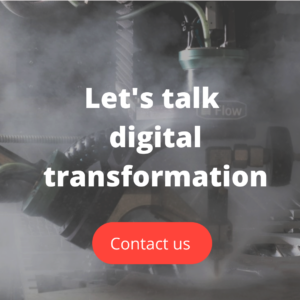91% of companies in the manufacturing sector have increased their digitization investments over the past two years, spending a total of $270 billion in 2020 alone. Digital supremacy in the manufacturing industry has arrived, and it’s making and breaking businesses.
This article explores what’s driving digitization in manufacturing. Because by understanding these drivers, you can pinpoint the factors that matter most to the success of your organization and focus on digital initiatives that have the greatest impact on value.
If you want to learn more about the current state of digitization in manufacturing, here’s what we cover:
Digitization in Manufacturing: It Means More Than Replacing Paper with Data
- What is Digital Transformation?
- The Benefits of Digital Transformation in Manufacturing
What’s Driving Digitization in Manufacturing
- Your Customers are Demanding Smarter, Connected Products
- Public Policy is Shifting to Address Climate Change
- New Product Development Paradigms Are Disrupting Traditional Value Chains
- COVID-19 Has Catalyzed Digitization in Manufacturing
The Bottom Line: Your Competitors Are Becoming Digital Manufacturers
Digitization in Manufacturing: It Means More Than Replacing Paper with Data
“Digitization in manufacturing” is a somewhat vague term referring to the shift from analog to digital in the manufacturing industry.
However, what most people mean when they talk about digitization in manufacturing–and what we refer to in this article–is digital transformation in manufacturing, which is a process that demands far more than simply replacing paper documents with electronic files.
What is Digital Transformation?
Digital transformation in manufacturing demands a total overhaul of every business activity, process, and model. It requires establishing a digital culture and adopting Industry 4.0 technologies to sell innovative products in innovative ways.
Contrary to popular belief, the key to digital transformation in the manufacturing industry is not digitizing existing processes or introducing more advanced technologies than your competitors. It’s leveraging technology to fundamentally change how you operate and deliver value to customers.
The Benefits of Digital Transformation in Manufacturing
By implementing digital transformation initiatives, manufacturers can:
– Connect every stage in the product lifecycle via a digital thread to enable rapid data transfer along the supply chain; improve data visibility, accessibility, and efficiency; and eliminate mistakes in manual translations of engineering specifications.
– Add value by applying digital technologies to products that support their customers’ own digital transformation goals.
– Build smart factories (intelligent and automated) to supercharge output and reduce downtime.
– Adopt profitable business models such as Equipment-as-a-Service to attract new customers and increase customer lifetime value.
– Become more sustainable by reducing energy consumption and wastage through better control, visibility, and accountability.
What’s Driving Digitization in Manufacturing
As manufacturing organizations continue to pursue digitization goals, the digital transformation in manufacturing market is forecast to grow from $263.93 billion in 2020 to $767.82 billion in 2026 (a CAGR of 19.48%)
What’s behind this meteoric increase?
A recent survey of 343 design engineers, manufacturing engineers, and service planners, carried out by Lifecycle Insights (2021 ROI of DX Study), identified increased customer demand for smart, connected products; sustainability requirements, regulations, and incentives; and the disruption of product development norms as the key drivers.
Your Customers are Demanding Smarter, Connected Products
Delivering quality products on schedule is no longer enough to keep customers satisfied.
Your customers want to buy smart, connected, data-driven products and partner with manufacturers that can seamlessly exchange information with their integrated supply chain.
Potential customers are implementing new digital processes for evaluating and selecting partners based on the technology they use. Manufacturers lagging in the digital transformation stakes are no longer considered viable suppliers.
Conversely, manufacturers that support their customers’ own digital transformation goals are experiencing increased demand. According to research from Deloitte, digitally mature companies are about three times more likely than lower-maturity companies to report annual net increases in revenue and profit margin.
It’s not only products and services but the buyer’s journey that customers want to be digitized. It doesn’t matter how complex your products are; companies like Amazon have conditioned your buyers to expect seamless, personalized, self-service experiences and a granular view of their order status.
As Brendan Witcher, VP and Principal Analyst at Forrester, explains: “Each time a consumer is exposed to an improved digital experience, their expectations are immediately reset to a new higher level.” Manufacturers that fail to meet expectations get dropped, and alternative suppliers are only ever a mouse-click away.
Public Policy is Shifting to Address Climate Change
Prospective customers and employees are putting increased pressure on manufacturers to become sustainable or risk missing out on their business and skills. Simultaneously, governments are implementing new environmental regulations (and incentives) with which manufacturers must comply.
Digitization in manufacturing provides multiple opportunities for manufacturers to meet sustainability expectations, lowering waste and emissions while reducing redundancy and costs (a win-win for business and the environment.)
The World Economic Forum’s Bridging Digital and Environmental Goals playbook makes multiple recommendations for creating products, strategies, and business models that minimize negative environmental impacts. Three such suggestions are:
- Embrace the Equipment-as-a-Service business model: Maintain ownership of products (equipment) but collect payment for output or usage time. This model reduces the overprovision of idle machines and encourages building for longevity over short-term profits.
- Reduce environmental impact throughout the supply chain: The Industrial Internet of Things (IIoT) arms manufacturers with sensors, algorithms, and communication networks to optimize the efficiency of their operations and supply chains. It provides visibility into energy use and increases accountability.
- Listen to internal and external stakeholders: Your customers want to buy from sustainable businesses–they’re under mounting sustainability scrutiny themselves. And attracting and maintaining talent–especially Millennials and Gen Zers–is far easier when you can demonstrate environmentally-conscious initiatives.
New Product Development Paradigms Are Disrupting Traditional Value Chains
Digital transformation means selling smart products that require a new development methodology, different from traditional gating processes.
Digital twins–virtual representations of products (product twin), production (production twin), and performance (performance twin)–are helping manufacturers design and launch innovative products faster, more cheaply, and with greater accuracy.
Another disruptive product development process is AI generative design which uses artificial intelligence to automate the creation of hundreds of validated designs based on defined problem statements and objectives.
COVID-19 Has Catalyzed Digitization in Manufacturing
A McKinsey survey of 800 executives found that 85% of companies have accelerated their digital transformation programs since the pandemic. Manufacturers with siloed data and a lack of transparency found themselves unable to adapt in the face of unprecedented disruption in both supply and demand, triggering investment in the digitization initiatives they sorely needed.
By adopting cloud computing, big data, automation, and AI, manufacturers have fortified their resilience to future shocks. They can now predict supply chain bottlenecks, shifts in consumer demand, and unknown threats before they happen, making quick changes to production processes, equipment, and suppliers.
Of course, COVID-19 has transformed the way we work, accelerating existing trends in remote work, e-commerce, and automation. Digitization in manufacturing is helping teams communicate and collaborate regardless of physical location, ensuring the right people have access to the correct data at the right time.
The Bottom Line: Your Competitors Are Becoming Digital Manufacturers
By adopting widely available and increasingly affordable Industry 4.0 technologies, your competitors are growing their revenues, improving efficiency, and boosting productivity in an age of ongoing complexity. It’s “transform or die,” as laggards are cut adrift from digital leaders. It’s time to become flexible, innovative, and sustainable by investing in digitization in manufacturing.

